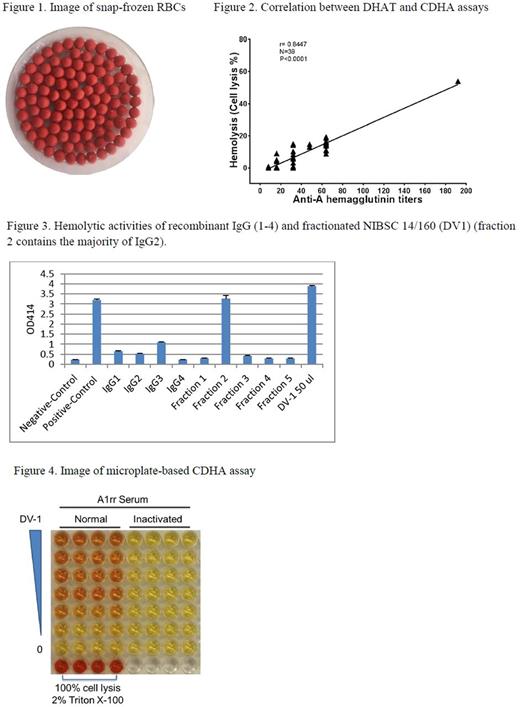Abstract
Introduction: Immune Globulin Intravenous (Human) (IGIV), as known as Intravenous Gamma-Globulin (IVIg), are therapeutic polyclonal immunoglobulin preparations manufactured from pooled human plasma. Initially licensed for replacement therapy of primary immune deficiencies, IGIV indications have expanded to include various autoimmune and inflammatory conditions. Hemolytic reactions associated with IGIV infusion were historically considered as uncommon, but seem to be more frequent over the past 5-6 years, coinciding with widespread manufacturing changes to increase IgG yield, and use of higher dosages. Anti-A and anti-B IgG isoagglutinins in the IGIV preparations are believed to mediate these events. In 2014, FDA co-organized a workshop to discuss strategies to address hemolytic complications of IGIV infusions (Scott 2015). Although US products all comply with an anti-A and anti-B specification of ≤1:64, using the European Pharmacopoeia direct hemagglutination test (DHAT) (Thorp 2010), hemolytic events have persisted. The DHAT is semi-quantitative, imprecise, and does not measure hemolytic function. However, hemolysin tests have been difficult to standardize, especially for highly concentrated IGIV products (Scott 2015).
This study reports development of a complement-dependent hemolysis assay (CDHA) suitable for testing IGIV products. We also tested a positive control preparation that is available from NIBSC (code 14/160), consisting of an IGIV lot that caused clinical hemolysis. Finally, we demonstrated differences among IGIV brands with respect to hemolytic activity.
Methods: To provide consistent reagents, serum from whole blood donations were frozen as a large volume source of complement and a droplet-freezing method was used to store Red Blood Cells (Schmid 2011; Figure 1). Critical assay conditions were studied, including enzymatic treatment of RBC, removal of unbound IgG, complement source and concentration, divalent cation concentrations, and pH. Hemolytic activities of IGIV products and a positive control IGIV preparation were compared to the hemagglutination results tested using DHAT method. The CDHA was also used to evaluate hemolytic activity of IgG subclasses.
Results: The most critical parameters for reproducible CDHA were complement source and preparation method, and assay pH. A pH of 6.5 (0.1M Tri-BIS buffer) was the most suitable condition for all of the tested IGIV analytes. Intra-laboratory variation was minimized by use of frozen RBCs and a consistent highly active complement preparation. The DHAT and CDHA results correlated with each other for most IGIV product lots (Figure 2). Hemolytic activity in IGIV lots varied among, in some cases within, brands. Enrichment of IgG subclass fractions from NIBSC 14/160 showed the highest hemolytic activity was present in IgG2 (Figure 3). In contrast, studies of recombinant anti-A monoclonal antibodies expressing the same anti-A F(ab'), but subclass-specific Fc receptors showed greatest activity of IgG3, consistent with evidence that IgG3 is the most potent complement-activating subclass. The role of IgG2 in hemolysis is not entirely surprising, as saccharide antigens often elicit IgG2 responses, and IgG2 can mediate complement activation (Diebolder 2014). Further subclass studies are planned.
Conclusion: Hemolytic activity of IGIV products mediated by anti-A isoagglutinins can be reproducibly measured in IGIV products (Figure 4). Compared to the DHAT method, CDHA provides a continuous readout, is less variable, amenable to use of a standard curve, and more precise. Historical challenges to reproducibility are addressed through biological reagent standardization and attention to critical conditions. Studies comparing the CDHA and DHAT methods across a wider range of products and hemolytic lots will discern whether the CDHA provides a better measure of product safety than the current DHAT lot release assay. The CDHA can be helpful for characterization of new manufacturing methods and products, and investigation of hemolytic events. Studies of hemolysis-implicated lots may provide a basis for improvements in product safety.
No relevant conflicts of interest to declare.
Author notes
Asterisk with author names denotes non-ASH members.


This feature is available to Subscribers Only
Sign In or Create an Account Close Modal